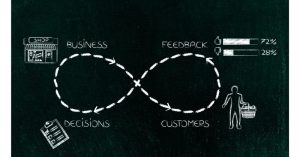The value of a customer feedback process is that it helps to constantly improve products and service. The only time a feedback process is successful, is when people share their insights openly. This includes looking at high response rate, genuine insights, multi channel approach among the few. In this blog, we will share the meaning and 5 best features to upgrade your customer feedback process.
What is The Customer Feedback Process?
A customer feedback process is a systematic approach of collecting feedback from your customer base and using that data to improve your business. The main aim of a successful feedback process is to engage customers in a way that they offer their genuine insights and relevant information during the feedback process. The information is converted into actionable data that is used to meet customer needs and improve CX.
How to create a successful customer feedback process?
Collecting customer feedback is a continuous process. It offers an opportunity to improve internal systems and improve external customer experience. There are ways to upgrade the feedback process that encourages people to share their candid responses. Here are some points to note while creating a customer feedback process that is actually engaging.
1. Focus on the purpose of the feedback process:
People are busy. They do not have the time to respond to unrelated questions. Focus on the goal of the survey. Is it related to product usage or the purchase experience? Is the survey related to the interaction between customer and the support team? Depending on the specific interaction, curate a survey that is relevant.
2. Steer clear of jargons and keep the language simple:
People will skip a survey if there is any jargon. Keep the language simple for every respondent. The main purpose of a survey is to encourage responses from your target user base. Keep your questions simple and do the point. This also means, avoid offering biased questions and nudging them to a particular answer.

3. Acknowledge every response and close the feedback loop:
People continue to stay with a brand when they feel valued. People share their grievances at various touchpoints- social media, third party review apps, Google maps or over the support team phone calls. Acknowledge them and offer solutions that can retain your customers. Close the feedback loop with every unhappy customer when possible. It is a well known fact that customer acquisition costs more than customer retention.
4. Create data-driven decision and keep customers informed:
Data-driven decisions are more than just analytics. It involves taking feedback and executing changes to make it easier for customers to do business with your company. When you make changes to certain products and services, inform the customer that their feedback made a difference with your company. This helps them feel valued that they are likely to stick with you. Complaints can be related to product features or slow support team. The motto is to improve gaps overall.
5. Take negative reviews on a positive note:
Companies would typically not want any detractors. Detractors are people who rate your products/ services negatively on the net promoter score scale. It is beneficial to improve your CX teams across. Research shows that 80% of people leave a brand due to bad customer service experiences. You can leverage the negative reviews, detect the pain points and work on these gaps. Focusing on detractors is a good way to turn them around to be a brand advocate. Think of them as an opportunity.
5 Best Features For A Customer Feedback Process
While scaling your business, it becomes impossible to keep track of every interaction. At this point, manual handling is out of the question. To keep systems running seamlessly, there are 5 best features that can upgrade your customer feedback process..
1. Omnichannel tracking across touch points
Customers interact with businesses through various channels like websites, social media channels, email, and mobile apps. Omnichannel tracking is critical to check if these channels are consistent with communication and branding. It is crucial to provide a seamless and consistent experience across all digital touchpoints. By implementing an omnichannel strategy, companies can ensure that customers have a unified and personalized experience across platforms. This will assure that businesses can have a more systematic customer journey mapping in place.
2. Systems to collect inmoment feedback
It is always wiser to collect customer feedback in real-time and in-the-moment. That way you can gauge the problems of unhappy customers and close the feedback loop at the earliest. Happy customers translate to customer success. This will be possible with real time feedback collection that can be mapped over the days, weeks or a few hours. Ditch the old batch-processing of data and opt for a faster way to gather actionable insights with Merren.
3. AI tools and instant analytics
Artificial intelligence can change the way CX marketers offer solutions. This can be in the form of a smart chat bot that has accurate answers at their disposal. AI offers a great facility to capture quantitative and qualitative feedback. They can be deployed over websites to grasp customer feedback. After collecting all the data on your dashboard, the AI tools can analyze complex data into comprehensive format. This removes manual assessments and encourages marketers to stay on top of the leaderboard.

4. Survey distribution via interactive channels
Survey distribution dictates your response rate. Choose interactive and in-context distribution channels. Messenger based applications are WhatsApp forms and Facebook messenger that are extensively used by people globally. Marketers can use the messenger apps to launch customer feedback surveys. A high response rate empowers customer support teams to make data-backed decisions. You can create Whatsapp surveys in less than 5 minutes and build your own Facebook messenger surveys in the current era.
Dynamic email surveys prevent people from moving into an external browser. The AMP function has been a new feature that was developed by Google where users can interact with the contents of an email body. Marketers can create their own satisfaction surveys such as net promoter score (NPS), customer satisfaction surveys (CSAT score) etc and gather quantitative data.

5. Mapping the journey of new and loyal customers
For most online purchases, people look up reviews, star ratings and social media comments on the products. In this case, it becomes extremely crucial to map the customer journey right from onboarding to the purchase and post-purchase experiences. This protocol will capture their experience with the product and their moment of truth at different points of usage. Satisfaction metrics like the customer effort score or CES can help marketers gauge the effort score of a purchase. When you capture negative feedback at any point, the customer support team can stay equipped to handle complex queries. Make sure that a marketer always invests in the best customer journey mapping tools.
Conclusion
The customer feedback process is a continuous process. It occurs at every stage of the sales funnel. This will dictate how a customer invests with the brand post-purchase. To stay ahead of the competition, invest in smart feedback process tools. Ease into a seamless workflow and leave manual tasks behind. To understand how Merren can FastTrack your customer feedback processes, sign up for a 14 day free trial.

